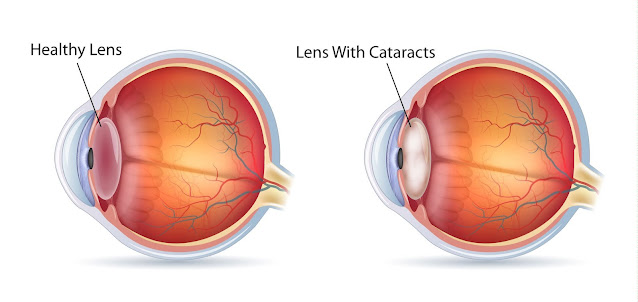Diabetic Retinopathy: An Overview Of This Vision-Threatening Complication Of Diabetes
What is Diabetic Retinopathy?
Diabetic retinopathy refers to damage to the retina, which is the
light-sensitive tissue at the back of the eye, caused by complications from
diabetes. Over time, high blood sugar levels from diabetes can damage blood
vessels in the retina. This can potentially lead to vision changes or even
vision loss if diabetic retinopathy isn't properly managed and treated.
Types of Diabetic Retinopathy
There are two main types of diabetic retinopathy - non-proliferative and
proliferative.
Non-Proliferative Diabetic Retinopathy
In the early stages of diabetic retinopathy, known as non-proliferative
diabetic retinopathy (NPDR), microaneurysms may form in the retina.
Microaneurysms are small bulges in the tiny blood vessels of the retina. As
NPDR progresses, some blood vessels may become blocked, and new blood vessels
may grow in the retina. This results in retinal swelling or fluid in the retina.
Proliferative Diabetic Retinopathy
More advanced Diabetic
Retinopathy is called proliferative diabetic retinopathy (PDR). In PDR,
an abnormal growth of new blood vessels, called neovascularization, develops on
the surface of the retina and the optic disc. These new blood vessels are
fragile and can easily rupture, causing vitreous or preretinal hemorrhage. If
left untreated, PDR eventually leads to a retinal detachment or severe vision
loss.
Risk Factors for Diabetic Retinopathy
The major risk factors for developing diabetic retinopathy include:
- Duration of diabetes - The longer a person lives with diabetes, the higher
the risk for developing retinopathy. Nearly all people with type 1 diabetes and
over 60% of people with type 2 diabetes have some stage of retinopathy after 20
years of living with the disease.
- Glycemic control - Poor blood sugar management, reflected in consistently
elevated A1C levels, increases the risk and progression of retinopathy. Keeping
blood sugar levels as close to normal as safely possible helps reduce the risk.
- Nephropathy - The presence of kidney disease, or nephropathy, from long-term
diabetes greatly increases the risk of developing retinopathy.
- Hypertension - High blood pressure raises the risk. keeping blood pressure
levels controlled is important for eye health.
- Pregnancy - Diabetic retinopathy can advance more rapidly in women with
diabetes during pregnancy. Careful screening during pregnancy and postpartum is
important.
- Smoking - Smoking cigarettes boosts the risk of developing diabetic eye
disease and accelerates its progression.
Symptoms of Diabetic Retinopathy
In the early stages of diabetic retinopathy, there are usually no detectable
symptoms or changes in vision. As the condition progresses, people may
experience:
- Blurred vision
- Trouble seeing at night or in poor lighting
- Difficulty with color vision or contrast in images
- Spots or dark strings floating in the field of vision
- Difficulty reading or seeing fine details
- Distorted or enlarged image of objects
Screening and Diagnosis
All people with diabetes should receive a comprehensive dilated eye exam at
least yearly from an ophthalmologist to check for any signs of retinopathy. The
eye doctor will dilate the pupils and examine the retina using an
ophthalmoscope or by taking photos of the retina. This allows early detection
of changes to the retinal blood vessels and appearance of lesions before any
vision symptoms develop.
Grading the Severity
During an eye exam, the ophthalmologist grades the severity of diabetic
retinopathy based on standard photographs:
- No retinopathy
- Mild NPDR
- Moderate NPDR
- Severe NPDR
- PDR
- Clinically significant macular edema (CSME)
This staging helps the doctor determine how often follow up exams should occur.
More frequent monitoring may be needed for higher levels of retinopathy or if
changes are detected on exams. For some advanced cases, imaging such as optical
coherence tomography may also be performed.
Treatment and Management
For non-proliferative retinopathy without macular edema, close monitoring with
eye exams is usually sufficient.
Early treatment focuses on controlling blood sugar, blood pressure, and
managing other cardiovascular risk factors. For more advanced cases, specific medical
or laser eye treatments may be needed to prevent vision loss.
- Lasers can be used to seal leaking blood vessels and prevent further damage
in cases of severe NPDR or PDR with vessels growing on the retina. Different
types of lasers are used depending on the extent of retinopathy.
- For diabetic macular edema, intravitreal injections of anti-VEGF medications
such as ranibizumab or aflibercept help shrink abnormal blood vessels and
reduce swelling in the macula. Multiple injections over months may be needed.
- In some cases, a vitrectomy surgery to remove the vitreous gel may be
performed if there is a vitreous hemorrhage or traction retinal detachment from
severe PDR.
With early diagnosis and appropriate treatment guided by an ophthalmologist,
diabetic retinopathy can often be managed effectively to preserve vision.
However, staying on top of office visits, screening, and glycemic control is
critical for reducing the risk of vision loss over time. Following the
ophthalmologist's treatment plan closely also maximizes outcomes.
In summary, diabetic retinopathy can progress from mild non-proliferative
changes to more severe proliferative disease involving retinal scarring and
neovascularization if hyperglycemia is not properly controlled. With early
detection and timely medical intervention upon progression, vision loss can
frequently be prevented or minimized. Maintaining good diabetes self-management
and adherence to eye care recommendations long-term remains key to protecting
sight.
Get more
insights, On Diabetic
Retinopathy
Check more
trending articles related to this topic: Rubber
Processing Chemicals Market




Comments
Post a Comment